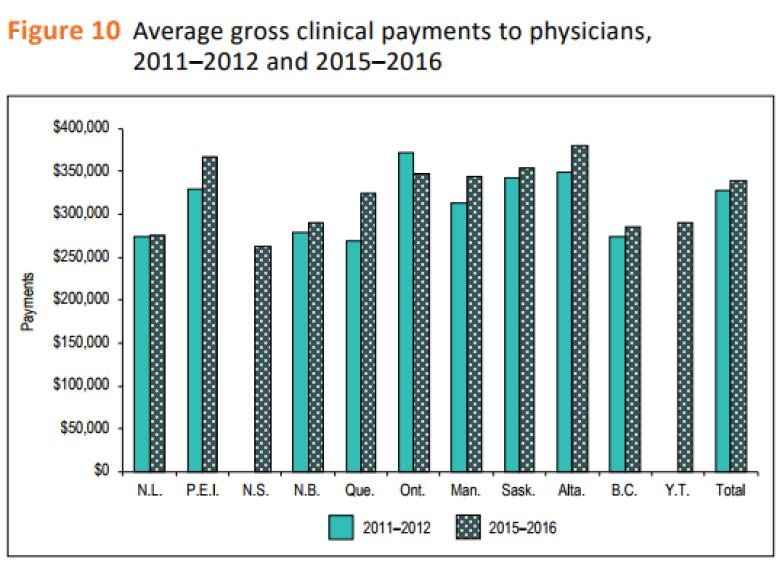Alberta doctors cost province $3.4B last year, up 9% over previous year
Alberta outpaces national averages in number of doctors setting up shop and they are the best paid

There are more doctors setting up shop inAlberta these days, and theyare billing the province for more and more money, according to a report released Thursday by the Canadian Institute for Health Information.
The annual report tracks the number of physicians across the country, as well as service payments covered under provincial and territorial medical care programs. Theinformation gathered is from2016.
Alberta outpaces national averages
Doctors in Alberta are paid on average $380,000 annually, which is the highest average in the country followed by P.E.I. and Saskatchewan. That average in Alberta was $366,000 just the year before in 2015.
"We actually see payments [in Alberta] increasing at a higher rate than the national average," saidWalter Feeney, the program lead in the physician information department at theCIHI.
"The overall clinical payments to physicians increased at just over nine per cent this past year in Alberta, to about $3.4 billion."

Alberta is seeing the fastest growth in gross payments when compared to all other provinces and territories. Feeney says both medical specialties as well as family practitioners are equally responsible for the increase in costs.
In the 2011-2012 year, Ontario had been paying the most to doctors on average, but Ontario has been successful at forcing down its average healthcare costs through various means, according to Feeney.
The numbers of physicians in the province also outpaced the national growth rate. Alberta now has 241 doctors per 100,000 citizens, whereas it was 217 in 2012.
Reason for trends in Alberta
There are a number of factors that have led to Alberta seeing the fastest growth in gross costs of physician services.
P.G. Forest,director of the University of Calgary's School of Public Policy, said while most of the data he read in the report seemed on par, he was shocked by the nine per cent rise in overall doctor costs in a single year.
He attributes the rising provincial bills to three factors: cost of living, fee structure used by the province, and overall healthcare system structure in Alberta.
"People are better compensated in Alberta in most fields of activity and it's true for physicians as it's true for everybody else. I think when you compare Alberta to any other province you have to correct for this factor," Forest said.
'A complex policy choice'
When compared to other provinces, Alberta pays the largest portion of their clinical payments through the fee-for-service payment structure, while other jurisdictions have moved towards alternative payment plans (APPs).
The general trend nation-widehas been towards APPs since the late 90s but in Alberta, APPs only account for 13 per cent of payments, while the national average is 28 per cent.
"Generally, [fee-for-service] increases productivity and volume, so it's a policy choice," Forest said.
Using Ontario as an example, he said, with their family physicians they've moved to using APPs more in recent years.
"But it has cost the province a lot of money to make that transition, so again, it's a complex policy choice," he added.
Fastest growing population
Feeney instead pointed out that Alberta continues to have the fastest growing population, which of course brings with it an increased demand for services.
"You have to consider that we have a larger population to be served," Feeney said.
Feeney said he sees no end in sight for the increasing bills to the province.
"If we look at the payment for physician services over ten years, it's increased by about 80 per cent. So the growth has slowed in more recent years but it's hard to predict what's going to happen in the future."
National trends
Nationally, physicians were paid$25.7 billion, the report found an annual increase of 3.4 per cent. That growth is well above national inflation which was pegged at 1.4 per in 2016, according to Statistics Canada.
Growth in clinical payments exceeded the growth from the year before, but is lower than the average growth seen in the last decade at 6.2 per cent.
The report tallied the number of physicians to be 84,063, an increase of 2.3 per cent, outpacing the growth of the national population which was 1.2 per cent, according to the World Bank.
"This is the tenth year in a row that we've actually seen the growth of the physician workforce outpace the general population, which basically means that we're seeing more physicians per person than ever before," Feeney said.
Forest said that is going to be keeping policy makers up at night for the foreseeable future.
"I don't think there is a single government now not only in Canada but in the developed world that is not preoccupied with the cost curve. It is a constant preoccupation of government and some are more successful than others."












_(720p).jpg)


 OFFICIAL HD MUSIC VIDEO.jpg)
.jpg)



























































































